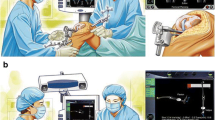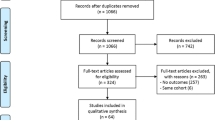Abstract
Computer-assisted total knee replacement (TKR) has been shown to improve radiographic alignment. Continuous feedback from the navigation system allows accurate adjustment of the bone cuts, thus reducing errors. The aim of this study was to determine the impact of experience both with computer navigation and knee replacement surgery on the frequency of errors in intraoperative bone cuts and implant alignment. Three homogeneous patient groups undergoing computer assisted TKR were included in the study. Each group was treated by one of three surgeons with varying experience in computer-aided and knee replacement surgery. Surgeon A had extensive experience in knee replacement and computer-assisted surgery. Surgeon B was an experienced knee replacement surgeon. A general orthopaedic surgeon with limited knee replacement surgery experience performed all surgeries in group C. The cutting errors and the number of re-cuts were determined intraoperatively. The complications and mean surgical time were collected for each group. The postoperative frontal femoral component angle, frontal tibial component angle, hip–knee–ankle angle and component slopes were evaluated. The results showed that the number of cutting errors were lowest for TKR performed by the surgeon with experience in navigation. This difference was statistically significant when compared to the general orthopaedic surgeon. A statistically significant superior result was achieved in final mechanical axis alignment for the surgeon experienced in computer-guided surgery compared to the other two groups (179.3° compared to 178.9° and 178.1°). However, the total number of outliers was similar, with no statistically significant differences among the three surgeons. Experience with navigation significantly reduced the surgical time.







Similar content being viewed by others
References
Bathis H, Perlick L, Tingart M, Perlick C, Luring C, Grifka J (2005) Intraoperative cutting errors in total knee arthroplasty. Arch Orthop Trauma Surg 125(1):16–20
Carter RE 3rd, Rush PF, Smid JA, Smith WL (2008) Experience with computer-assisted navigation for total knee arthroplasty in a community setting. J Arthroplasty 23(5):707–713
Chin PL, Yang KY, Yeo SJ, Lo NN (2005) Randomized control trial comparing radiographic total knee arthroplasty implant placement using computer navigation versus conventional technique. J Arthroplasty 20:618–626
Cobb JP, Kannan V, Brust K, Thevendran G (2007) Navigation reduces the learning curve in resurfacing total hip arthroplasty. Clin Orthop Relat Res 463:90–97
Confalonieri N, Manzotti A, Pullen C, Ragone V (2005) Computer-assisted technique versus intramedullary and extramedullary alignment systems in total knee replacement: a radiological comparison. Acta Orthop Belg 71:703–709
Daubresse F, Vajeu C, Loquet R (2005) Total knee arthroplasty with conventional or navigated technique: comparison of the learning curves in a community hospital. Acta Orthop Belg 71(6):710–713
Ek ET, Dowsey MM, Tse LF, Riazi A, Love BR, Stoney JD, Choong PF (2008) Comparison of functional and radiological outcomes after computer-assisted versus conventional total knee arthroplasty: a matched-control retrospective study. J Orthop Surg (Hong Kong) 16(2):192–196
Jeffery RS, Morris RW, Denham RA, 5 (1991) Coronal alignment after total knee replacement. J Bone Joint Surg Br 73(5):709–714
Jenny JY, Mielke RK, Giurea A (2008) Learning curve in navigated total knee replacement: A multi-centre study comparing experienced and beginner centers. Knee 15(2):80–84
Lewold S, Knutson K, Lidgren L (1993) Reduced failure rate in knee prosthetic surgery with improved implantation technique. Clin Orthop Relat Res (287):94–97
Longstaff LM, Sloan K, Stamp N, Scaddan M, Beaver R (2009) Good alignment after total knee arthroplasty leads to faster rehabilitation and better function. J Arthroplasty 24(4):570–578
Lotke PA, Ecker ML (1977) Influence of positioning of prosthesis in total knee replacement. J Bone Joint Surg Am 59:77–79
Lüring C, Oczipka F, Perlick L, Tingart M, Grifka J, Bäthis H (2009) Two year follow-up comparing computer assisted versus freehand TKR on joint stability, muscular function and patients satisfaction. Knee Surg Sports Traumatol Arthrosc 17(3):228–232
Mahaluxmivala J, Bankes MJ, Nicolai P, Aldam CH, Allen PW (2001) The effect of surgeon experience on component positioning in 673 press fit condylar posterior cruciate-sacrificing total knee arthroplasties. J Arthroplasty 16:635–640
Manley M, Ong K, Lau E, Kurtz SM (2008) Total knee arthroplasty survivorship in the United States Medicare population effect of hospital and surgeon procedure volume. J Arthroplasty; Oct 31 [Epub ahead of print]
Otani T, Whiteside LA, White SE (1993) Cutting errors in preparation of femoral components in total knee arthroplasty. J Arthroplasty 8(5):503–510
Plaskos C, Hodgson AJ, Inkpen K, McGraw RW (2002) Bone cutting errors in total knee arthroplasty. J Arthroplasty 17(6):698–705
Reed SC, Gollish J (1997) The accuracy of femoral intramedullary guides in total knee arthroplasty. J Arthroplasty 12(6):677–682
Ritter MA, Faris PM, Keating EM, Meding JB (1994) Postoperative alignment of total knee replacement. Its effect on survival. Clin Orthop Relat Res 153–156
Sampath SA, Voon SH, Sangster M, Davies H (2008) The statistical relationship between varus deformity, surgeon's experience, BMI and tourniquet time for computer assisted total knee replacements. Knee 16(2):121–124
Santini AJ, Raut VT (2008) Ten-year survival analysis of the PFC total knee arthroplasty—a surgeon's first 99 replacements. Int Orthop 32(4):459–465
Seon JK, Park SJ, Lee KB, Li G, Kozanek M, Song EK (2008) Functional comparison of total knee arthroplasty performed with and without a navigation system. Int Orthop; Jun 28 [Epub ahead of print]
Slover JD, Tosteson AN, Bozic KJ, Rubash HE, Malchau H (2008) Impact of hospital volume on the economic value of computer navigation for total knee replacement. J Bone Joint Surg Am 90(7):1492–1500
Sparmann M, Wolke B, Czupalla H, Banzer D, Zink A (2003) Positioning of total knee arthroplasty with and without navigation support. A prospective, randomized study. J Bone Joint Surg Br 85:830–835
Yau WP, Chiu KY, Zuo JL, Tang WM, Ng TP (2008) Computer navigation did not improve alignment in a lower-volume total knee practice. Clin Orthop Relat Res 466(4):935–945
Author information
Authors and Affiliations
Corresponding author
Rights and permissions
About this article
Cite this article
Manzotti, A., Cerveri, P., De Momi, E. et al. Relationship between cutting errors and learning curve in computer-assisted total knee replacement. International Orthopaedics (SICOT) 34, 655–662 (2010). https://doi.org/10.1007/s00264-009-0816-z
Received:
Revised:
Accepted:
Published:
Issue Date:
DOI: https://doi.org/10.1007/s00264-009-0816-z




